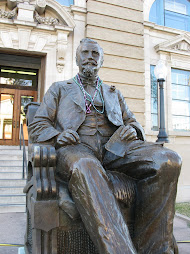
During the month of April, the Rosenberg Library will display several examples of antique beer steins. These artifacts were originally made in Germany between the early and late 1800s. Three were donated to the library by W.R.A. Rogers (1869-1937), and one was given by Fred Burton (1876-1938). Mr. Rogers was a prominent Galveston businessman and member of the Rosenberg Library Board of Directors for many years. Mr. Burton was in the cotton and later the insurance industry, and he also served as the Galveston Quartet Society’s first director.
The earliest types of drinking vessels known as steins date back to the 16th century. Most scholars and historians credit the Germans for this invention. Steins, also referred to as tankards, are containers with handles and hinged lids. These lids were used to protect the liquid contents from flies and other pests, a sanitary measure taken after millions in Europe fell victim to the bubonic plague. Steins were made in a variety of shapes and sizes, and the decoration on the vessels ranges from primitive designs to elaborate masterpieces.
During the 16th and 17th centuries, steins were usually made from brown clay and were hand painted using several colors. From the early 18th century on, raised relief decoration and more color were added. By the later half of the 19th century, stein making had reached its pinnacle, becoming a true art form. In addition to clay, pewter, porcelain, colored glass, silver, and even ivory were used to craft beer steins. Etched or painted scenes on steins portrayed figures drinking, dancing, and hunting. “Character steins” were cartoon-like vessels in the shape of animals or vegetables with expressive facial features. Some hand-painted vessels depicted exceptionally realistic military or occupational scenes.
Companies such as Villeroy and Boch, Merkelbach and Wick, Marzi and Remy, and HR began mass producing beer steins during the 1800s. Most of these manufacturers stamped their steins with distinctive makers’ marks, and many steins were engraved with the words “musterschutz” or “geschüzt” on the base. This meant that that particular design was patented and that its duplication by another company was prohibited by law. Steins that have the word “Germany” on the base indicate a production date after 1892. At that time, national law mandated the practice of identifying export goods.
Beer steins that pre-date the mid 19th century were usually one-of-a-kind drinking vessels. Often, these were made to order, and depending on size, quality, and craftsmanship, some steins were quite expensive to produce. These earlier custom-made beer steins are highly sought after by today’s collectors. The values of some steins—particularly the oldest and most unusual examples—have gone up significantly over the past several decades.
The Rosenberg Library Treasure of the Month can be viewed Monday through Saturday, 9 a.m. to 5 p.m. The artifacts will be on display in the Hutchings Gallery, located on the library’s third floor. For more information, please contact Eleanor Clark at 409-763-8854, ext. 125 or at
eclark@rosenberg-library.org.





